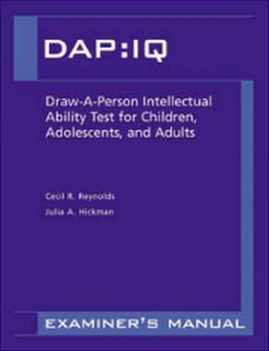Dap Scoring Manual
The Developmental Assets Profile (DAP) The Developmental Assets Profile is social-emotional assessment which measures the internal strengths and external supports of young people, and their growth in these key areas over time. Measure young people’s social-emotional skills with the research-based Developmental Assets Profile (DAP).
- GOODENOUGH DRAW – A – PERSON TEST. DIRECTIONS: “I want you to make a picture of a person. Make the very best picture that you can. Take your time and work very carefully. Try very hard and see what a good picture you can make.” TIME: No time limit. Usually 10 minutes will suffice with young children.
- Read PDF Scoring Guide For Dap Testdrawings that can be recognized as attempts to represent the human figure. Each point is scored plus or minus. GOODENOUGH DRAW – A – PERSON TEST Top score for front is 46; top score for side view is 51. The standard deviation at a given age is around 7 to 8 points.
Scoring Rubric for DAP Site Visit Assignment
Previewing page 1 of actual document.
View the full content.Dap Scoring Manual Software
Dap Scoring Manual Test
View Full DocumentView Full Document
Scoring Rubric for DAP Site Visit Assignment
00432 views
- Pages:
- 2
- School:
- Winthrop University
- Course:
- Eced 332 - Introduction to Early Childhood Education
Sign up for free to view:
- This document and 3 million+ documents and flashcards
- High quality study guides, lecture notes, practice exams
- Course Packets handpicked by editors offering a comprehensive review of your courses
- Better Grades Guaranteed
Unformatted text preview:
ECED 332 Scoring Rubric for DAP Site Visit Assignment Name Points 50 Unistructural Needs Work 34 points Below Part I Classroom Observations Observation notes are not attached to written report Observation notes are vague and or do not include factual nonjudgmental descriptions Part II Completed Observation Guide Form No evidence of review of the DAP manual Minimal focus on 2 elements within each category of DAP Includes vague examples of DAP related to teaching activities materials other classroom practices Completed observation guide is not attached to written report Written Observation Summary Introduction approximately page in length Descriptions of classroom students are vague and unclear Summary of Observation Guide approximately 3 4 pages Interpretations of observation guide notes do not link classroom teaching practices to categories of DAP Two or fewer examples of classroom teaching practices are unclear or not included Conclusion approximately page Classroom or teaching strengths are unrelated to DAP DAP citations rationale were not provided Questions that build upon observations are unclear or are not included Multistructural Meets Expectations 35 46 Points Part I Classroom Observations Observation notes are attached to written report Observation notes are objective descriptive i e factual nonjudgmental descriptions Part II Completed DAP Observation Form Evidence of review of the DAP manual Focuses attention on 3 elements within each category of DAP Includes examples of DAP related to teaching activities materials other classroom practices Completed observation guide is attached to written report Written Observation Summary Introduction approximately 1 page in length Provides an accurate description of classroom students in specific concrete terms Summary of Observation Guide approximately 4 5 pages Interpretations of observation guide notes link classroom teaching practices to categories of DAP Three examples of classroom teaching practices are provided
 View Full Document
View Full DocumentDap Assessment
- PRODUCTS
Systematic method for evaluating the process used in a common drawing task to evaluate cognitive abilities
Cecil Reynolds and Julia Hickman
- Ages: 4-0 through 89-11
- Testing Time: 10-12 minutes
- Administration: Individual or Group
The Draw-A-Person Intellectual Ability Test for Children, Adolescents, and Adults (DAP:IQ) provides a common set of scoring criteria to estimate intellectual ability from a human figure drawing. Until now, measurement of cognitive ability by scoring drawings of human figures focused mainly on children and adolescents. The DAP:IQ applies this form of evaluation to adults as well, allowing for a more direct, continuous measurement of a common construct across the age range.
The DAP:IQ improves the practice of evaluating human figure drawings (HFDs) as a measurement of cognitive ability by scoring elements representative of universal features of the human figure. The collection of a HFD is easily standardized with a set of simple, easily understood instructions, and requires a very short period of time.
This flexible assessment is for use by psychologists, school counselors, and professionals working with special-needs populations. The DAP:IQ allows you to derive reliable, quantitative ability estimates by using the largest single collection of normative data on this task ever gathered. Psychometric data, including normative reference data, are provided for ages 4 years to 89 years and are based on a total sample of 3,090 individuals across the United States. The validity and utility of this test lie in the scoring system¹s emphasis of concepts over artistic skill and motor coordination.
Features of the DAP:IQ
- Standardized instructions for the task are easy to derive
- Standardized scoring systems emphasize conceptual aspects of drawings, not artistic quality
- Drawings collected in a rapid, efficient manner
- Few people are hesitant to do the drawing once they are assured that the artistic quality is not being evaluated
- Drawings can be obtained in even the most challenging of clinical situations (such as the assessment of autistic or severely hyperactive children, non-reading or non-English speaking clients)
- Scoring criteria have less cultural specificity than most intelligence tests, verbal or nonverbal (culture-reduced)
- All you need to give and score of the DAP:IQ is the test manual, the Administration/Scoring Form, and a sharpened pencil.
Dap Scoring Manual Transmission
COMPLETE DAP:IQ KIT INCLUDES:Examiner's Manual, 50 Administration/Scoring Forms, and 50 Drawing Forms, all in a sturdy storage box. (2004)
